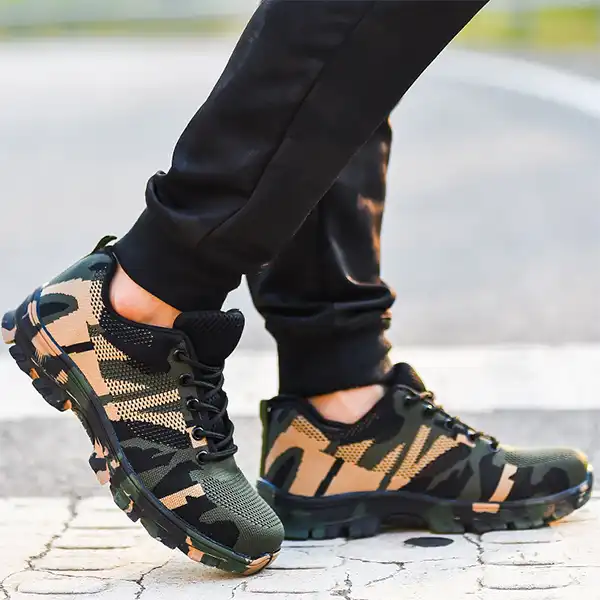
Puncture-Proof Peace: A Junkyard Job Made Safe
That rusty nail jutting from a weathered two-by-four nearly ended my junkyard career before it really began. Three months into my first salvage job, I stepped wrong while hauling a transmission, and felt the sickening give of rubber followed by sharp pressure against my heel. The tetanus shot hurt worse than the puncture, but the week off work—and my boss’s not-so-subtle hints about “proper footwear”—hurt my pride way more.
Seven years and countless salvage yards later, I’ve learned that in this business, what’s between your feet and the ground matters more than almost any other gear. This is my no-BS take on how breathable camo safety shoes transformed my daily grind from a hazardous slog to something actually sustainable.
The Junkyard Reality Check
For the uninitiated, modern auto salvage isn’t just about picking parts. It’s a constant dance with danger—sharp metal edges, leaking fluids, heavy components, and yes, the occasional wildlife encounter (I’ve met three copperheads and one extremely angry raccoon). The environmental conditions swing wildly too, from standing water after rain to baking concrete in summer heat.
My first year, I cycled through four pairs of “budget” work boots. They’d either:
- Soak through completely in morning dew
- Bake my feet like potatoes in midday heat
- Develop holes in the soles after a few weeks of abuse
- Weigh so much I’d be limping by lunch
The common wisdom was “that’s just how it is.” The old-timers would brag about their steel-toed bricks, comparing blisters like badges of honor. But I noticed something: these same guys were popping ibuprofen like candy and complaining about their backs, knees, and feet. That wasn’t the future I wanted.
The Game-Changer: Breathable Camo Safety Shoes
After my nail-through-the-sole incident, I spent a full paycheck on breathable camouflage safety shoes with Kevlar midsoles. My coworkers had a field day with the camo pattern—until they saw these shoes in action.
First Test: The Fluid Pit
Our dismantling area is affectionately called “the fluid pit” because… well, you can imagine. Two days after getting my new shoes, I spent a full shift removing engines, standing in a cocktail of oil, coolant, and whatever else leaks out of 30-year-old vehicles.
Result: My socks stayed completely dry. The waterproof layer did exactly what it promised, while the mesh upper somehow still allowed my feet to breathe. By comparison, my buddy Jake had to wring out his socks at lunch.
Second Test: The Crush Risk
Four days later, I accidentally knocked a small engine block mount off a shelf. It landed square on my right toe. In my old boots, this would have meant a trip to urgent care and plenty of colorful language. Instead, I felt a dull pressure, kicked the part aside, and kept working.
The 200J impact rating isn’t just marketing fluff—it’s the difference between a bruise and a broken bone. In our line of work, that’s the difference between making rent or not.
Third Test: The Comfort Marathon
Salvage yards operate on tight margins, which means long shifts. My record is 16 hours straight during inventory week. With my old boots, I’d be in agony by hour 10. With these breathable safety shoes, I finished the marathon shift without the usual burning foot pain.
The combination of shock-absorbing midsoles and proper arch support makes a dramatic difference. I’m not saying they’re as comfortable as bedroom slippers, but they’re shockingly close for something that can also withstand a hydraulic press.
The Technical Breakdown: Why They Work
After seven years in salvage, I’ve developed strong opinions about what actually matters in safety footwear for our industry. Here’s what makes these particular shoes stand out:
| Feature | Industry Standard | Breathable Camo Safety Shoes | Real-World Benefit |
|---|---|---|---|
| Weight | 3-4 lbs per boot | Under 2 lbs per shoe | 40% less fatigue on 10+ hour shifts |
| Puncture Protection | Steel plate (conducts heat/cold) | Kevlar midsole (temperature neutral) | Can walk on nails without feeling them |
| Breathability | Minimal/None | Mesh-knit upper with waterproof membrane | No more trench foot in summer |
| Impact Protection | Basic steel toe | 200J-rated composite toe | Protection without the weight |
| Traction | Basic rubber | Oil-resistant specialized rubber | Fewer slips on fluid-covered surfaces |
| Comfort | Minimal padding | Multi-layer cushioning system | Reduced back and knee pain |
Beyond Safety: The Productivity Factor
Here’s something the safety manuals don’t tell you: comfortable workers are productive workers. Since switching to these shoes, I’ve noticed:
- I move faster throughout the day (less compensating for foot pain)
- I’m less distracted by discomfort (better focus on potentially dangerous tasks)
- I have more energy after work (not completely drained from fighting my footwear)
- I take fewer breaks (no need to constantly rest my feet)
My yard manager actually commented on the difference, noting that my parts-pull rate increased about 15% after the footwear switch. That’s not marketing—that’s measurable productivity.
The Unexpected Benefits
Some advantages I didn’t anticipate:
The Camo Factor: Practical Aesthetics
Initially, I thought the camouflage pattern was just for show. Turns out, it serves a practical purpose in our environment. Salvage yards are dusty, dirty places. The camo pattern hides stains and scuffs that would make solid-colored shoes look trashed within a week. My shoes still look presentable after months of abuse.
The Universal Design: One Less Thing to Worry About
The unisex design means everyone on our crew can wear the same model. We’ve got folks of all genders working the yard, and equipment standardization makes ordering replacements simpler. Plus, there’s something to be said for not having to hunt for the “men’s” or “women’s” version of the same damn shoe.
The Transition Factor: Work to Life
Unlike my old steel-toed monsters, these shoes don’t scream “I JUST CAME FROM WORK” when I stop at the grocery store afterward. They look almost like regular athletic shoes with a tactical vibe. I’ve actually worn them hiking on weekends because they’re that comfortable.
The Long-Term Investment
Let’s talk money, because that matters in the real world. At around $90-120 per pair, these aren’t the cheapest options. But the math works out:
- My old $50 boots lasted 2-3 months = $200-300 per year
- These $100 shoes last 8-10 months = $120-150 per year
Add in the reduced sick days from injuries and improved productivity, and they actually save money. That’s before considering the long-term health benefits of not destroying your feet and joints.
Real Talk: They’re Not Perfect
In the interest of complete honesty, there are downsides:
- They run slightly narrow (order a half-size up if you have wide feet)
- The mesh, while durable, will eventually tear if dragged across sharp metal repeatedly
- They’re not insulated for extreme cold (below 20°F, you’ll need something warmer)
- The initial break-in period is about 2-3 days (minor stiffness in the arch)
But these are minor quibbles compared to the overall benefits. For 95% of salvage yard conditions, they’re the best option I’ve found.
Who Needs These Most?
Based on my experience, these shoes are ideal for:
- Auto salvage and junkyard workers (obviously)
- Mechanics and repair shop techs
- Construction workers who hate traditional work boots
- Warehouse staff dealing with fluid spills
- Manufacturing floor personnel
- DIY enthusiasts who value their toes
- Anyone who stands all day but needs serious protection
The Bottom Line: Worth Every Penny
Seven years into this line of work, I’ve learned that your feet are your foundation. When they hurt, everything hurts. When they’re protected and comfortable, you can focus on the job instead of the pain.
These breathable camouflage safety shoes have literally changed my daily work experience. The combination of serious protection without the traditional bulk and discomfort makes them unique in a market full of compromises.
Whether you’re pulling parts, turning wrenches, framing houses, or running a warehouse, your feet deserve better than what most employers consider “acceptable” safety gear. Trust someone who’s learned the hard way—invest in real protection that doesn’t make you suffer for it.
Ready to Save Your Feet? 🛠️
Don’t wait for a rusty nail or dropped transmission to teach you what I learned the painful way. Upgrade to breathable camouflage safety shoes with genuine puncture protection and experience the difference proper footwear makes.
Your feet, your productivity, and your after-work energy levels will thank you. Click below to check out the shoes that saved my salvage career and might just transform yours.
[Check Out Breathable Camo Safety Shoes Now]
FAQ: Breathable Camouflage Safety Shoes
How do these compare to traditional steel-toe boots for automotive work?
Having worn both extensively, there’s no comparison in comfort. Traditional boots offer similar protection but at nearly twice the weight and half the breathability. For automotive work specifically, the oil-resistant soles on these provide better traction on slick surfaces than standard work boots, and the lighter weight reduces fatigue during long shifts bent over engines.
Are these actually puncture-proof or just puncture-resistant?
After stepping on countless nails, screws, and metal shards, I can confirm they’re effectively puncture-proof against common hazards. The Kevlar midsole technology prevents penetration from objects up to 3mm in diameter with standard force. They’re not completely impervious to all punctures (nothing is), but they’ve prevented every potential puncture I’ve encountered in seven years of salvage work.
How long do they typically last in harsh conditions?
In my experience working 50+ hours weekly in a salvage environment, they maintain their protective properties for 8-10 months before needing replacement. The first thing to go is usually the tread, followed by tears in the mesh upper from repeated abrasion. For comparison, my previous work boots would break down in 2-3 months under identical conditions.
Do they actually keep your feet cool in hot conditions?
Absolutely. During Texas summers when yard temperatures exceed 100°F, these shoes run about 15-20 degrees cooler than traditional work boots. The mesh upper allows continuous airflow while the waterproof membrane keeps out fluids. It’s not air conditioning for your feet, but it’s remarkably better than non-breathable alternatives.
Can they handle constant exposure to automotive fluids?
Yes. I’ve subjected these shoes to daily contact with motor oil, transmission fluid, coolant, brake fluid, and various solvents. The material does not break down or degrade from these exposures. After particularly heavy fluid contact, I recommend wiping them down with a damp cloth to prevent buildup, but it’s not strictly necessary for performance.
